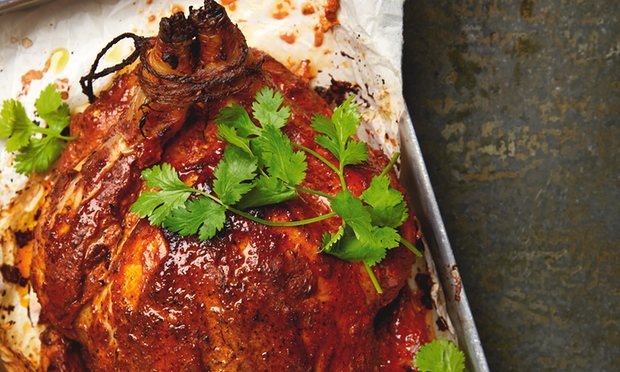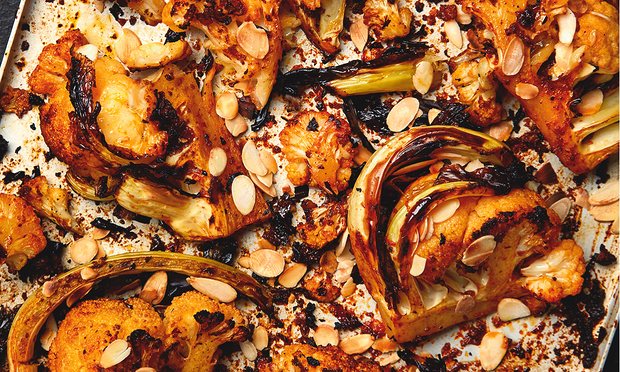Yotam Ottolenghi's tandoori recipes
I find it amazing that we'll teach teenagers to drive before they can work the oven. Get them started with these easy recipes…

Yotam Ottolenghi's tandoori chicken. Photograph: Louise Hagger for the Guardian. Food styling: Emily Kydd. Prop styling: Jennifer Kay
The idea of kids' food or teenage cooking is not a natural one for me. When I was growing up, I simply wanted to eat what my parents were cooking: there just wasn't the option (or desire) for a separate and bespoke service. It's only in recent years that I've realised how lucky I was to take this togetherness for granted. For many people, feeding children can be complex – traumatic, even – but I'm yet to be convinced that having a kids' menu in a restaurant, or routinely offering to cook something different, is the way forward.
It's the same with cooking. If you grow up regarding it as something that only grown-ups do, it's no wonder so many teenagers come to "proper" cooking really late in life. I find it amazing that we'll happily teach our teenagers to drive a car before a lot of them know how to work the oven.
I'm not suggesting that, out of the blue, you ask your 16-year-old to whip up a tandoori paste, rub it over a chicken and make Sunday lunch; but for any curry-loving teenager, the possibility should not be dismissed out of hand. Making things yourself – seeing the ingredients, how they are combined, why the end result looks the way it does – helps demystify the cooking process. If you can read, you can cook. And if you can cook, chances are you'll be more receptive to trying out a much wider range of foods than teenagers are often given credit for.
Tandoori paste
This takes less than 10 minutes to make, and keeps well in the fridge for at least three weeks. These quantities make about 300g paste, so there'll more than enough to make all three of today's recipes. It's easily doubled (or more), if you want to try it out on other things: on cubes of tofu or paneer, say, or root vegetables for roasting. The paste also works well as a curry base: just mix some with plain yoghurt and use as a marinade for cubes of meat or fish before they are grilled.
Put the chillies in a small bowl, cover them with boiling water, set aside for five minutes to rehydrate, then drain.
Put the cumin, coriander, peppercorns, cardamom and cinnamon in a small frying pan on a medium heat, and toast for three to four minutes, until the spices start to brown and go aromatic. Grind to a powder (I use a spice grinder), then tip into a small food processor bowl. Add the rehydrated chillies, 90ml cold water, all the remaining ingredients and a quarter-teaspoon of salt, and work for a couple of minutes, until you have a smooth paste. Refrigerate until ready to use.
Tandoori chicken
Homemade tandoori chicken beats a ready meal any day. Serves four.- 150g tandoori paste (see previous recipe)
- 200g Greek yoghurt
- 2 tsp lemon juice
- Salt
- 1 chicken (2.2kg)
- 2 tbsp olive oil
- 5g small coriander sprigs, stems and leaves, roughly chopped
In a large bowl, mix the paste, yoghurt, lemon juice and three-quarters of a teaspoon of salt. Add the chicken and rub it all over with the mixture, until well coated, then set aside to marinate for at least an hour (or overnight in the fridge, if you're preparing this in advance).
Heat the oven to 200C/390F/gas mark 6. Put the chicken in an oven tray lined with baking paper – you need a smallish one, so it fits snugly – and brush (or rub) all over with oil. Roast the chicken for 25 minutes, then baste, cover with foil and roast for another 45 minutes, basting twice more. Turn up the heat to 210C/410F/gas mark 6½, remove the foil and roast for a final five minutes.
Remove the chicken from the oven and leave to rest at room temperature for five to 10 minutes. Serve with any pan juices and the coriander sprinkled on top.
Grilled tandoori prawns and pineapple salad
These sweet, spicy prawns and pineapple are gorgeous with the crunchy iceberg lettuce. Make sure you scrape all the cooking juices from the baking tray into the salad, so you get all the flavour. Toast the mustard seeds in a small pan on a medium heat, until they just start to pop. Serves four.
- 1kg tiger prawns (ie about 20 prawns; defrosted if frozen), peeled but with the tails intact, and deveined
- 60g tandoori paste (see first recipe)
- 1 large garlic clove, peeled and crushed
- Salt
- 2 tbsp groundnut oil
- ½ medium pineapple, peeled, cored and cut into 1cm-thick rounds
- 2 tbsp lime juice, plus 1 lime, quartered, to serve
- ½ large iceberg lettuce, cut into 3cm wedges
- 10g basil leaves
- 1 tsp mustard seeds, lightly toasted
Put the prawns, two-thirds of the paste, the garlic, a third of a teaspoon of salt and a tablespoon of oil in a bowl, mix to coat and put in the fridge to marinate for an hour.
Heat the oven to 200C/390F/gas mark 6. Put a ridged griddle pan on a high heat and ventilate the kitchen. Once the griddle is very hot, grill the pineapple slices in batches for about a minute each, turning them halfway. Once all the fruit is grilled and cool enough to handle, cut each slice into 10 little triangular wedges and put them in a large bowl.
Put the prawns on the griddle and grill for a minute, turning them once halfway, until blackened on both sides. Add the prawns to the pineapple bowl with the remaining tandoori paste and a tablespoon of oil. Toss to coat, then spread out on a medium oven tray lined with baking paper, and roast for five to seven minutes, until the prawns are just cooked through.
Spoon everything into a large bowl – make sure you get every last scrap and all the juices – then add the lime juice, a quarter-teaspoon of salt, the lettuce, basil and mustard seeds, and toss. Spoon on to a large platter (or into individual bowls) and serve at once with the lime wedges.
Tandoori cauliflower wedges

Yotam Ottolenghi's tandoori cauliflower wedges. Photograph: Louise Hagger for the Guardian. Food styling: Emily Kydd. Prop styling: Jennifer Kay
These are gorgeous: serve just as they are as a side, or maybe with plain yoghurt, or turn them into a starter or light meal in their own right by serving with a bowl of rice. Serves four as a side dish.
- 1 large cauliflower (1kg), leaves left on, first cut in half vertically through the root (so each half stays intact) and then each half cut vertically into 4 thick wedges 50g ghee
- 50g tandoori paste (see first recipe)
- 1 small preserved lemon, seeds discarded, flesh and skin finely chopped
- 1½ tsp honey
- Salt
- 30g flaked almonds, lightly toasted
Heat the grill to its highest setting.
Put the cauliflower in a large bowl. Put the ghee, paste, lemon, honey and half a teaspoon of salt in a small saucepan and put on a high heat. Stir until the ghee melts, then pour over the cauliflower wedges. Mix well (don't worry if the wedges break up slightly), then arrange on a large oven tray. Put the tray under the grill about 10cm away from the heat source, and cook, turning regularly, for about 25 minutes, until charred all over and cooked through.
Put the charred cauliflower wedges (and any bits and pieces that have broken off) on a large serving plate, scatter over the flaked almonds and serve hot.
• Yotam Ottolenghi is chef/patron of Ottolenghi and Nopi in London.